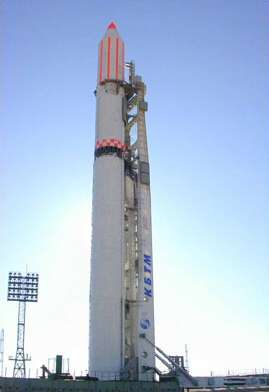Meteor-3M No.1
 | |
| Mission type | Weather |
|---|---|
| Operator | Roscosmos/Roshydromet |
| COSPAR ID | 2001-056A |
| SATCAT № | 27001 |
| Mission duration |
Planned: 3 years Actual: ~5 years |
| Spacecraft properties | |
| Manufacturer | VNIIEM |
| Launch mass | 2,500 kilograms (5,500 lb) |
| Payload mass | 800 kilograms (1,800 lb) |
| Power | 800 watts |
| Start of mission | |
| Launch date | 10 December 2001, 17:18:57 UTC |
| Rocket | Zenit-2 |
| Launch site | Baikonur 45/1 |
| Orbital parameters | |
| Reference system | Geocentric |
| Regime | SSO |
| Eccentricity | 0.00135[2] |
| Perigee | 1,016 kilometres (631 mi) |
| Apogee | 996 kilometres (619 mi) |
| Inclination | 99.64 degrees[2] |
| Period | 105.3 minutes[2] |
The Meteor-3M No.1, was the first and only of the Meteor-3M series polar-orbit weather satellites. It was launched on 10 December 2001 at 17:18:57 UTC from the Baikonur Cosmodrome in Kazakhstan.[3] The satellite was in a sun-synchronous orbit with an ascending node time of about 9 AM.
An APT transmission was planned to only have a reduced resolution (2 km) visible channel data. The status of any APT capability on this satellite is unclear, but it is thought not to have an APT transmitter. No APT transmissions have been received from this satellite. SLR mission support began on 1 May 2002.

Secondary mission objective is the flight testing of the novel-type spherical retroreflector for precise laser ranging.
ILRS Mission Support Status: SLR will be used for precise orbit determination and retroreflector research.
Instrumentation:
- SAGE III
- Spherical retroreflector
- Other weather monitoring instruments
RetroReflector Array (RRA) Characteristics: The retroreflector is a glass ball 60 mm in diameter, fastened in a holder providing observation from Earth at elevations more than 30° (the retroreflector field of view is centered in the Nadir direction). The spherical retroreflector with it holder is fixed to the Meteor-3M No.1 spacecraft. The expected return signal strength level is between LAGEOS and ETALON.
SAGE III
Meteor-3M No.1 includes the SAGE III (Stratospheric Aerosol and Gas Experiment) payload and other instruments designed to measure temperature and humidity profiles, clouds, surface properties, and high energy particles in the upper atmosphere. SAGE III is a gyrating spectrometer that measures ultraviolet/visible energy that will be used to enhance our understanding of natural and human-derived atmospheric processes by providing accurate long-term measurements of the vertical structure of aerosols, ozone, water vapor, and other important trace gases in the upper troposphere and stratosphere.
See also
References
- ↑ "Научный Центр Оперативного Мониторинга Земли". www.ntsomz.ru. Retrieved 2016-04-03.
- 1 2 3 "NASA - NSSDCA - Spacecraft - Trajectory Details". nssdc.gsfc.nasa.gov. Retrieved 2016-04-03.
- ↑ "Meteor satellite". www.russianspaceweb.com. Retrieved 2016-04-03.
External links
- Sputnik server
- eoPortal Meteor overview
- SAGE III Meteor 3M
- SAGE III Meteor 3M platform
- NASA - Goddard Space Flight Center Scientific Visualization Studio
- Augmented-reality display of Meteor satellites